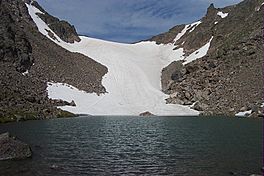Andrews Glacier facts for kids
Quick facts for kids Andrews Glacier |
|
|---|---|

Andrews Glacier viewed from the outlet of Andrews Tarn
|
|
| Type | Mountain glacier |
| Location | Larimer County, Colorado, U.S. |
| Coordinates | 40°17′15″N 105°41′02″W / 40.28750°N 105.68389°W |
| Terminus | Talus |
| Status | Retreating |
Andrews Glacier is a beautiful glacier found high up in the mountains. It sits in a bowl-shaped valley called a cirque, just below Otis Peak in Rocky Mountain National Park in Colorado, USA. This glacier stretches from Andrews Pass, which is about 12,000 feet high, down to 11,700 feet. Some snow stays frozen all year long and reaches a small lake called Andrews Tarn, which was formed by the glacier itself.
Contents
What is Andrews Glacier?
Andrews Glacier is known as an alpine glacier. This means it's a glacier that forms in mountain areas. It's located in a special type of valley called a cirque. A cirque is like a giant, natural armchair carved into the side of a mountain by the glacier's own movement.
Where is it Located?
This glacier is nestled in the stunning Rocky Mountain National Park. You can find it in Larimer County, Colorado. It sits beneath a mountain called Otis Peak, which is very tall, reaching about 12,486 feet (3,806 meters) high. The glacier starts near Andrews Pass and flows down towards Andrews Tarn, a small lake.
How Glaciers Form
Glaciers like Andrews Glacier start to form when snow falls and doesn't melt completely during the summer. Over many years, more and more snow piles up. The weight of the new snow presses down on the older snow, squeezing out the air. This process turns the snow into a very dense, hard ice. Once the ice becomes thick enough, gravity starts to pull it slowly downhill, causing the glacier to move.
Why Glaciers Change
Glaciers are always changing. They can grow bigger or shrink smaller depending on how much snow falls and how much ice melts. Scientists use something called glacier mass balance to describe this.
Understanding Glacier Mass Balance
- If a glacier gets more snow than it loses through melting and evaporation, its mass balance is positive. This means the glacier is growing.
- If a glacier loses more ice through melting than it gains from new snow, its mass balance is negative. This means the glacier is shrinking or retreating.
Andrews Glacier is Retreating
Sadly, Andrews Glacier is currently retreating. Scientists know this by comparing old photographs from the early 1900s with newer ones from the early 2000s. These pictures clearly show that the glacier has become much smaller over time. This shrinking is a sign of a negative mass balance, meaning it's melting faster than it's growing.


